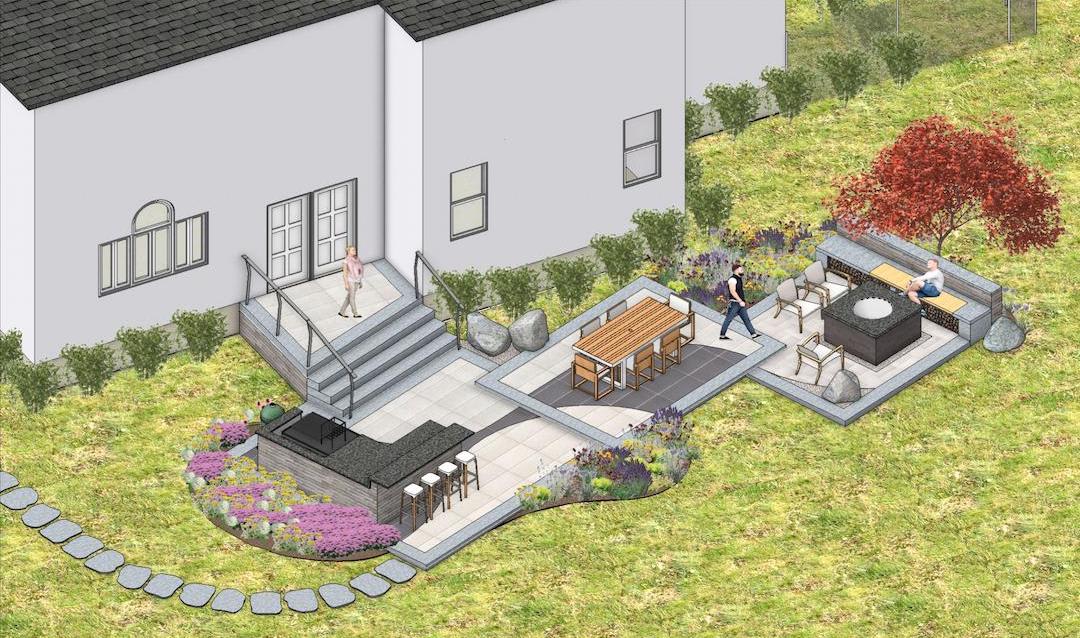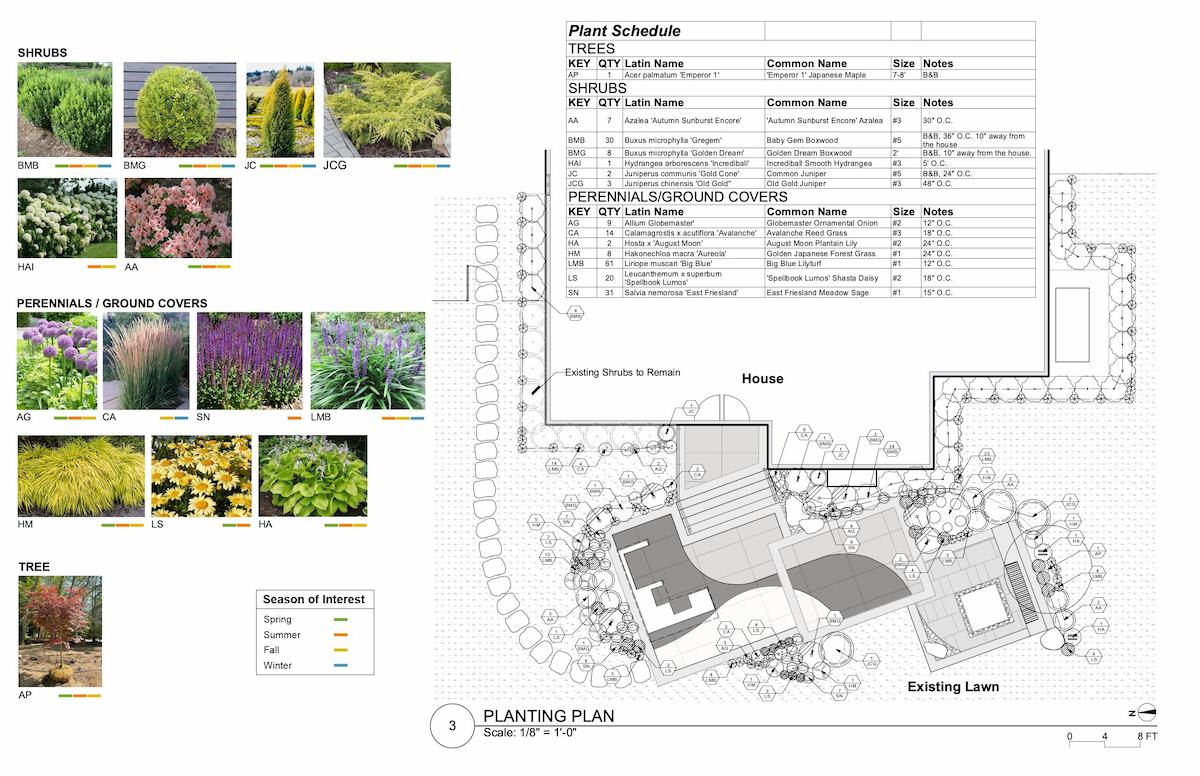
Curbs Studio, a landscape design-build firm from Massachusetts, shows us that winning work is a constant consideration in the design process.
The firm specializes in transforming residential yards. “We work with people who are living in their forever homes,” said Lucas Machado, Curbs director of operations. “A lot of our clientele are people who appreciate the design-build process. They’re looking for a phased approach to developing their dream home.”
These forward-thinking clients tend to think in the present day while also anticipating what they’ll want their “personal oasis” to look like, Machado said. However, bigger dreams require deeper budgets.
Working with a design/build practice like Curbs can mean finalizing the entire site design vision at the front end and implementing additions as budget permits. “The clients are empowered to have a greater long-term vision and work towards it piece by piece with us instead of all at once, which also ensures that the final product is uniform,” he said.
The clients are empowered to have a greater long-term vision and work towards it piece by piece with us instead of all at once, which also ensures that the final product is uniform.Lucas Machado, Director of Operations, Curbs Studio

The Curbs Studio Design-Build Process
Initial consultations occur over Zoom. Here, Machado and Rong Rong, Curbs’ director of landscape architecture, try to gain a sense of the client’s goals for their site. Then a site visit occurs to catalog existing conditions like property lines, sunlight and shading, and grading. Rong documents this information in Vectorworks Landmark, where she’ll later create and detail a site model.
But first, Machado, Rong, and the client must reach an iron-clad understanding of development intentions for the site. Rong uses the Morpholio Trace app on an iPad to sketch out proposed site elements that align with the client’s initial keyword indicators — for an ongoing project, one of these words was “industrial.” These initial sketches can include things like retaining walls, custom fire pits, porches, or other site furniture.
It’s the magic of Vectorworks and Rong’s talent that clients can throw out an idea and then start to see it come to life in the model.Lucas Machado, Director of Operations, Curbs Studio

Curbs designs predominantly custom site elements rather than purchasing them pre-made, Rong said. Sometimes pre-made elements don’t fit the client’s site both practically and conceptually. Designing their own pieces, Rong explained, allows Curbs to be flexible with what the client wants without being limited by what’s purchasable in a store. It’s also a bit of revision control — engaging the client frequently about these elements before modeling occurs, Machado explained, is a better alternative to spending substantial time modeling and developing one idea that may need to be redone anyway if the client doesn’t approve.
Rong, who’s responsible for the bulk of the technical design process within Curbs Studio, imports approved sketches into Vectorworks and places them on the site. At this point the sketches are still 2D; she’s thinking about space, shade, sizes, and relative positioning as she builds the Vectorworks file. “It’s the magic of Vectorworks and Rong’s talent that clients can throw out an idea and then start to see it come to life in the model,” Machado said.
Rong takes those initial sketches and precisely models them in Vectorworks while simultaneously documenting information needed to build them. This data is carried into worksheets that are linked with the geometry itself, so she’s able to input changes to the spreadsheets and have them reflect in the model automatically.
She considers material selections following layout and modeling. “We love being able to use real pictures of material surfaces as textures in Vectorworks. It adds a lot of realism to our models,” Rong said. Following material selections, she creates a set of schematic drawings for presentation and virtual reality videos to share with the client. If the client approves, Rong further details the models and prepares the project to be implemented onsite.
The Advantages of Modeling and Visualization
It hardly needs to be stated that visualizing design elements comes with a range of advantages. Even simple things like the sketches Curbs creates at the start of their process are crucial to guiding clients through the project’s journey.
Curbs’ visualization extends far beyond initial concept drawings, though. Once Rong models the custom pieces, she creates shop drawings and visual diagrams to help fabricators like carpenters and blacksmiths create the objects. She’s careful to be precise; these diagrams are what carry sketches into reality.
We love being able to use real pictures of material surfaces as textures in Vectorworks. It adds a lot of realism to our models.Rong Rong, Director of Landscape Architecture, Curbs Studio

Adding graphics to 2D plan drawings also helps inform clients through the review process. Rong’s plan drawings are both easy to interpret and attractive; the graphics legend distinguishes between existing elements and proposed additions, and each feature on the drawing is clearly labeled.

Final renderings invite the client to explore their new space before it’s built. These renderings are key to ensuring the client gets what they want from the design. In the rendering below, the custom fire pit shown diagrammatically above can be seen in the greater context of the site.

A holistic process in Vectorworks gives us a competitive advantage over those who use other software programs.Lucas Machado, Director of Operations, Curbs Studio
Choosing Vectorworks Landmark for Landscape Design-Build
In many ways the all-in-one nature of Vectorworks Landmark aligns with the mission of Curbs Studio: to be a full-service, one-stop-shop solution.
“A holistic process in Vectorworks gives us a competitive advantage over those who use other software programs,” Machado said.
The software is crucial to Curbs Studio as they fulfill the “build” domain of their design-build practice. That’s clear from the fabrication drawings mentioned earlier. Rong does something similar with the site’s planting plan: once she’s finished laying out plants, she sends a complete plant schedule to local nurseries to acquire them. The schedule is automatically created in Vectorworks based on the model.
“We can see the total number of plants and their costs, which is very helpful for the client,” Rong said.
She also includes images of the selected plants in the plans so the clients can see exactly what they’re agreeing to have planted on their property. In Landmark, this can be done easily by importing images as resources or pulling them from their plant database records. “We think it’s really important for the client to understand what colors they’re getting and when those colors will bloom,” she said.

Learn more about Curbs Studio.
Learn more about Vectorworks Landmark.
Stay in the know with the latest insights
Subscribers receive news, customer stories, success and learning tips, event information, and other important announcements from Vectorworks.
By submitting this form, you agree that Vectorworks, Inc. and its authorized partners may contact you in regards to news, offers, and the use of our software, services, and platforms. Learn more about our privacy practices and your data on our privacy page.*